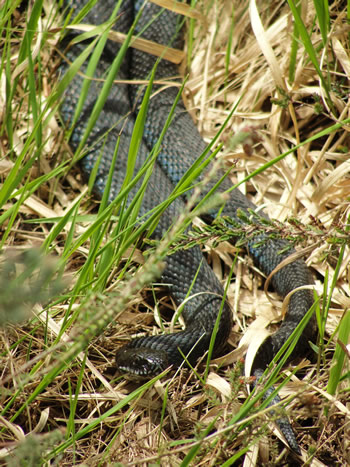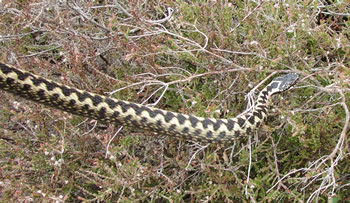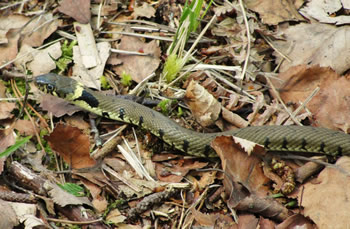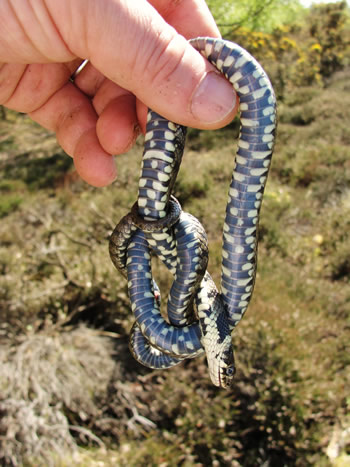I visited a site where I had previously seen a huge black female adder (vipera berus)two years ago. I only saw her once but did not manage to get a photo. It was not the first black specimen that I have seen but she was the largest adder that I had ever seen. I had returned many times but had not seen her.Today I saw another smaller black female, half the size but with a blue tint to her.I had once seen blue common lizards in a small colony in mid Dorset but had not seen melanistic snakes with blue in them before. She had not shed her skin recently as she would have been brighter, but the colour was lovely. Black adders are common and the further north one goes, the greater the chance, as they can absorb more heat thus survive better in cooler climates. Melanism occurs rarely in grass snakes and even rarer in smooth snakes.
 A typical male adder has bold zigzag markings on a light background, often white but occasionally brown. Black adders are usually females; this helps when she is thermo regulating and incubating her embryos, and adders as with most viper species do not lay eggs but are viviparous.In northern latitudes, depositing eggs is risky as guaranteed warmth is patchy;it makes better sense to go to the warmth oneself and then development of young is much faster. Here is a male for comparison.
A typical male adder has bold zigzag markings on a light background, often white but occasionally brown. Black adders are usually females; this helps when she is thermo regulating and incubating her embryos, and adders as with most viper species do not lay eggs but are viviparous.In northern latitudes, depositing eggs is risky as guaranteed warmth is patchy;it makes better sense to go to the warmth oneself and then development of young is much faster. Here is a male for comparison.
 The grass snake(Natrix narix) are so different from adders.Here is a young male on the scent of a female. He is late mating or maybe did not get a chance to do so. sometimes grass snakes mate late resulting in a late clutch of eggs being layed. They often fail to hatch. They are deposited in warm vegetation such as decomposing matter such as compost heaps and manure.The third native British snake species the smooth snake (coronella austrica) also give live birth.
The grass snake(Natrix narix) are so different from adders.Here is a young male on the scent of a female. He is late mating or maybe did not get a chance to do so. sometimes grass snakes mate late resulting in a late clutch of eggs being layed. They often fail to hatch. They are deposited in warm vegetation such as decomposing matter such as compost heaps and manure.The third native British snake species the smooth snake (coronella austrica) also give live birth.
 Here is another smaller specimen playing dead;a survival tactic.
Here is another smaller specimen playing dead;a survival tactic.

